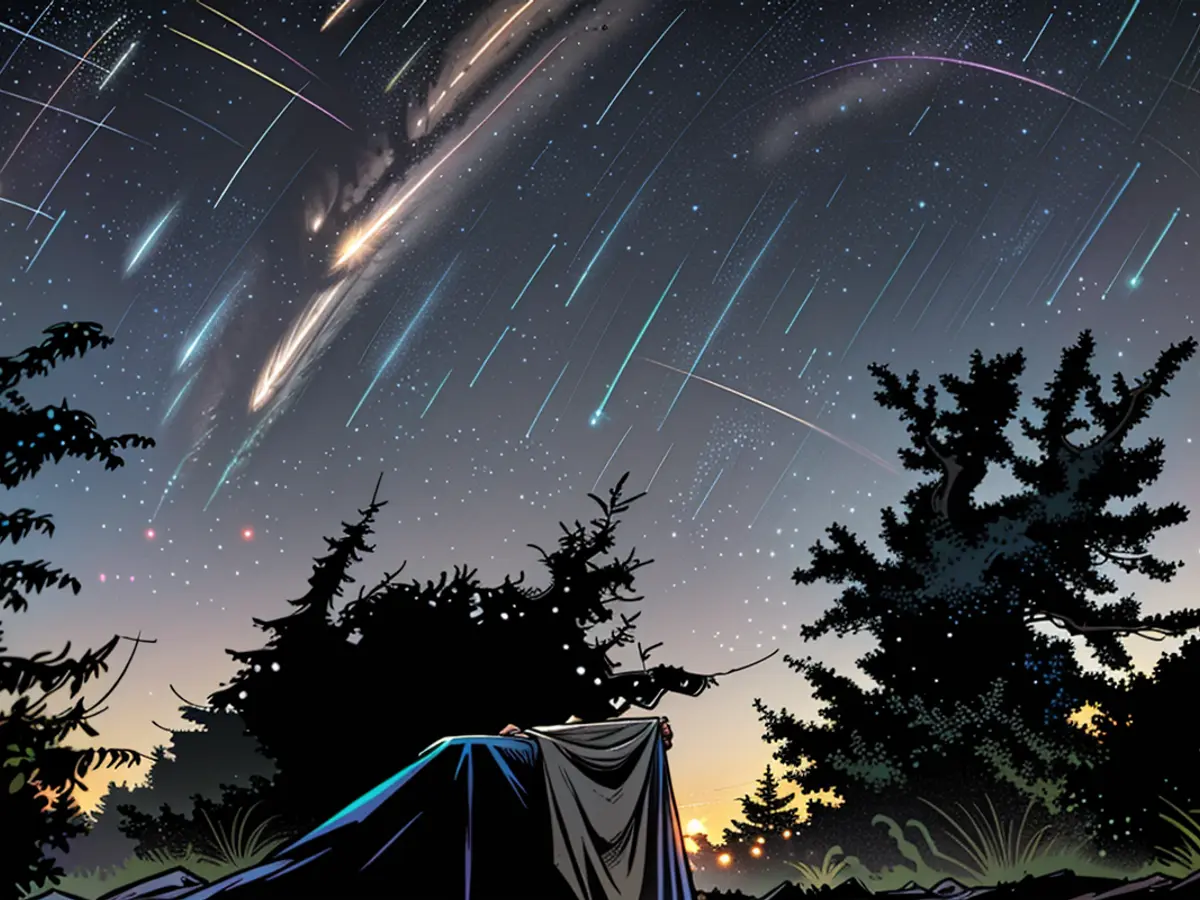starry sky - Sun, Moon and Stars in August - Persied Meteor Shower
August begins with a nightly sky spectacle: A large number of Perseids meteors align with the stream of Perseus. The maximum occurs between the 9th and 13th of August. Bright objects, called Bolides or Fireballs, are common.
Most meteors are expected in the early morning hours of the 12th of August. The Persids offer up to a hundred meteors per hour at their peak. The best observation time is between 11:30 p.m. and 3:30 a.m.
With an entry speed of 60 kilometers per second, the Persids are fast objects. The journey from Earth to the Moon took only 90 minutes. Most meteoroids vaporize in Earth's atmosphere. However, there are exceptions, some meteors hit the ground or plunge into the sea. Very rarely, a meteorite strikes populated areas.
Another unique celestial event of the month: The nearly full Moon covers the planet Saturn. Our neighbor in space passes by the Ringed Planet on the early morning of Wednesday, August 21st, and obscures it for an hour. The exact times vary by location. In Hamburg, the cosmic spectacle begins at 5:33 a.m., in Berlin at 5:34 a.m., in Düsseldorf at 5:31 a.m., in Leipzig at 5:30 a.m., and in Munich at 5:33 a.m.
An hour later, the Moon releases Saturn, and Saturn appears at the edge of the Moon. The occultation is particularly impressive in the telescope as the ring and planetary sphere gradually disappear behind the Moon's edge and reappear an hour later at the dark edge of the Moon.
Saturn in the Constellation of Aquarius becomes the nighttime planet in August. At the beginning of the month, it rises around 10:30 p.m., and by the end of August, it rises only a half hour after sunset. Venus appears in the evening sky and begins its evening star period. It is the first star to be visible in the waning evening twilight.
Already on the 4th, Venus approaches Regulus, the Lion's Head Star, from the north. The following day, the waning crescent Moon meets Venus. At the end of August, Venus crosses the celestial equator in a southern direction. Its settings shift from 9:46 p.m. to just before 3 a.m.
Mars is the planet of the second half of the night. It moves through the constellation of Taurus and passes by Aldebaran, the Bull's Head Star, at a five-degree northern distance at the beginning of the month. In the middle of August, the red Mars encounters Jupiter to the north.
Jupiter rules the second half of the night. A beautiful nighttime view occurs on the 28th around 3 a.m.: The waning Moon joins Mars and Jupiter above the eastern horizon. Mercury overtakes the Earth on the 19th on the inner orbit. The quick planet remains invisible in August.
The Summer Triangle now stands high in the southern sky. Steep above our heads, we see Vega in the constellation of Lyra. Near the Lyre, the Swan spreads its wings. It is marked by a large star pattern, also known as the "Northern Cross." Its brightest star Deneb marks the second corner of the Summer Triangle.
Deneb is the most distant of the bright stars of the first magnitude. Its distance is 2,500 light-years. It belongs to the so-called Red Giants with a diameter about 200 times that of the Sun and a luminosity 50,000 times greater than ours. Deneb thus ranks among the largest and brightest stars in our Milky Way.
Atar, the third star of the Summer Triangle, forms the main star of the Eagle, which dives onto its prey. With a distance of 17 light years, the Eagle Star is one of our Sun's neighboring stars.
The Great Bear has sunken towards the northwest, while in the northeast, the constellation of Cassiopeia rises.
The glittering band of the summer Milky Way is only visible in August far beyond earthly light smog. The faintly glowing band of thousands of twinkling stars can therefore be observed by many people only rarely or never. Moonlight disturbs visibility. New Moon will be reached on August 4 at 13:13 hours. Full Moon enters the constellation of Waterman on August 19 at 20:26 hours. The Moon is located 405,297 kilometers away in deep space on the 9th, while it is only 360,196 kilometers away from us on the 21st.
The Sun moves along the descending branch of its annual path and approaches the Celestial Equator. On the 10th, it leaves the constellation of Cancer and switches to Leo, passing by its main star, Regulus, the King Star, on the 22nd. On the same day, it enters the constellation of Virgo in the afternoon.
The solar noon height decreases by about 9 degrees, the solar day length shrinks in 50 degrees north by approximately two hours.
- The city of Stuttgart, in Germany, is an excellent location to observe the night sky due to its minimal light pollution.
- A Starling, a type of bird, can often be seen in urban areas, including Düsseldorf and Hamburg, during the day.
- Media-Saturn-Holding, a German retail company, has stores in multiple cities across Germany, including Leipzig and Munich.
- Germany is home to many astronomical institutions, such as the Max Planck Institute for Astronomy in Heidelberg and the German Aerospace Center in Cologne, which contribute to scientific research in the field of astronomy.
- On Monday night, stargazers in Berlin can expect a powerful display of Jupiter's Great Red Spot, a storm that has been raging on Jupiter for over 300 years.
- In the constellation of Cancer, there's a star named Alphard, also known as the Heart of the Crab, which is visible from Leipzig and other parts of Germany.
- The annual Leipzig Book Fair, which showcases literature from around the world and attracts many visitors, takes place in Leipzig, Germany, usually in March, and is not related to stargazing but worth noting as it's a popular cultural event.







